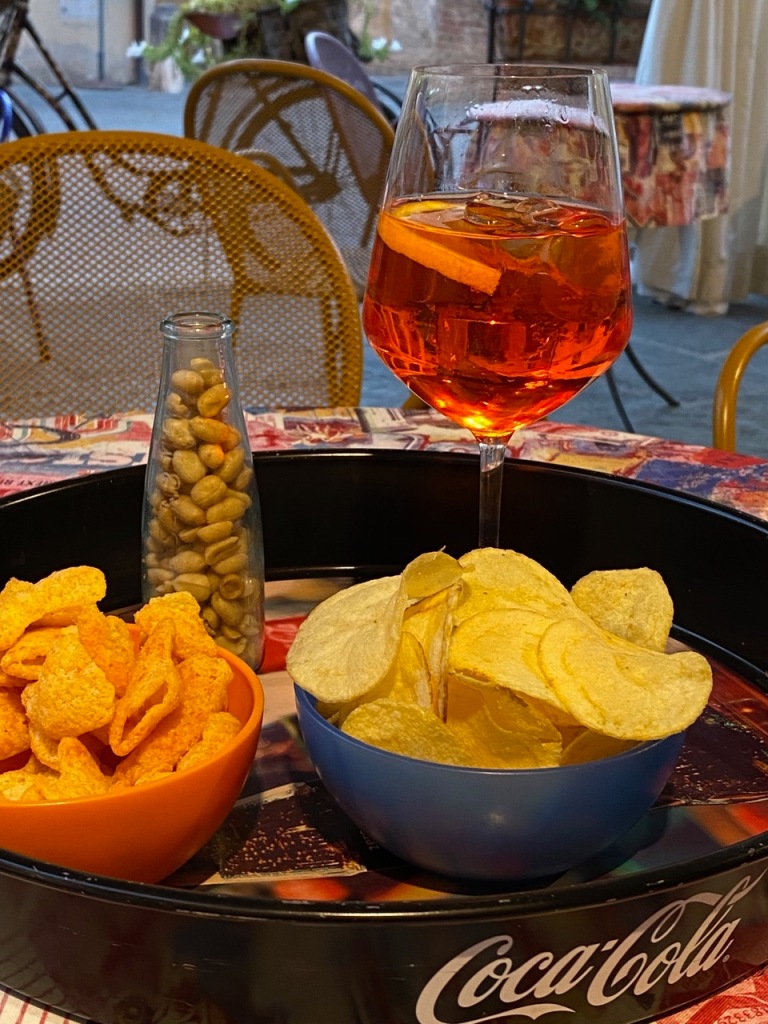A few years ago, chalkboard signs advertising “Apericena” started appearing outside bars here in Italy—cheap bars in the provinces, not swanky lounges in Milano. It had long been possible to order an evening drink (at the same bar where you took your morning coffee) and sip it while standing at the counter and munching on beer nuts, or, often, slices of focaccia or panini unashamedly sliced from the remains of the lunch rush. For students or anyone else on a tight budget, this was one way to spend your supper budget on drinks and still get something of a meal. I remember when I started hearing the word “apericena” used, tentatively, by friends. “Let’s meet for an aperitivo,” Nadia would suggest. “No–an ‘apericena,’” she’d correct herself, playfully trying out the new expression. We took to the concept fast. A combination of the words “aperitivo” and “cena” (dinner), “apericena” suggests a light meal. The word conveys parsimony, too: we wouldn’t be splurging on a rich dinner, just treating ourselves to a drink and a snack. Never mind that these “apericenas” often segued into meals; they started in a temperate spirit.

Lately, “apericena” has been moving in on entertaining at home. Tuscans have a “braccio corto,” it is said—a short arm. In other words, they hate to spend. Now that “apericena” is a thing, one can invite one’s friends over without committing to cooking and serving the three-course meal that’s the norm here. “Apericena” is low risk, too—who can’t pour chips into a bowl or set out a block of cheese? And non-committal: it’s understood that one hasn’t promised to satiate the guests.
In the US, restaurants and cafés are mostly selling munchies to their cocktail-drinking customers, not handing them out for free, as the bar near my house does when you buy a €3 Spritz. Still, even including the free snacks, the bars here must be earning a healthy profit. The bubbly wine they use for mixed drinks such as the Spritz has long ceased to be Venetian Prosecco; most bars use the least expensive spumante they can find. It costs €1 to make a Spritz, so even my bar can afford to provide peanuts.
I tried my first Spritz on a sunny terrace in the Dolomities in February of 2017. We had just stopped for lunch half-way around the Sella Ronda, the network of ski slopes west of Cortina, which one can ski all day, clockwise or counterclockwise, without needing to repeat a slope. It was my boyfriend’s parents that had introduced me to the luxury of having an aperitivo before lunch: at their country house in Castell’Anselmo near the Tuscan coast, they gathered in the living room just before 1:00pm for a glass of light white wine, or, around the holidays, Champagne, and pistachios and olives or slices of pecorino, while they waited for aunts, uncles and cousins to walk over from the other house, sons and daughters to arrive from Florence or Rome and grandchildren to come in from the yard. In the summer, a pitcher of Hugos was sometimes mixed: Prosecco, sambuca-flower syrup, lemon juice and fresh mint over ice—a cocktail that epitomizes summer, whereas a Spritz is intrinsically linked to winter for me.
As anyone who has been to a bar in Europe in the last five years knows, Prosecco, Prosecco-based cocktails and especially Spritzes have taken over café tables from Oslo to Otranto. Last Friday night, sitting on the Piazza del Campo in Siena with my Goddaughter and her friend, we could see a Sprtiz on every table. Humans like sugar, and Aperol and Campari are sweet (26g and 24g of sugar per litre respectively), as well as tangy and bitter. Who invented the Sprtiz is a matter still contested–Was it a Venetian barman serving Select (yet another kind of bitter liqueur) with still white wine or the Padovans serving Aperol and bubbly?—as is the cause of the recent boom in the Spritz’s popularity, although the marketing department at Campari (which owns both Aperol and Campari) was no doubt key. And what is the best liqueur to use? Aperol for the neophyte, Campari for the sophisticates, Select and a squeeze of fresh orange for authenticity seekers. My favorite, Gamondi, is for the individualists!
My boyfriend’s family’s lunchtime “aperitivi” are no longer: his mother died a few years ago, and the family has stopped gathering for weekend, or even holiday, meals. Like everyone else, we’re eating and drinking less, watching our weight, our cholesterol, our blood pressure. Long, leisurely lunches hardly fit into our lives these days. Still, I hope the “apericena” will never entirely replace them.